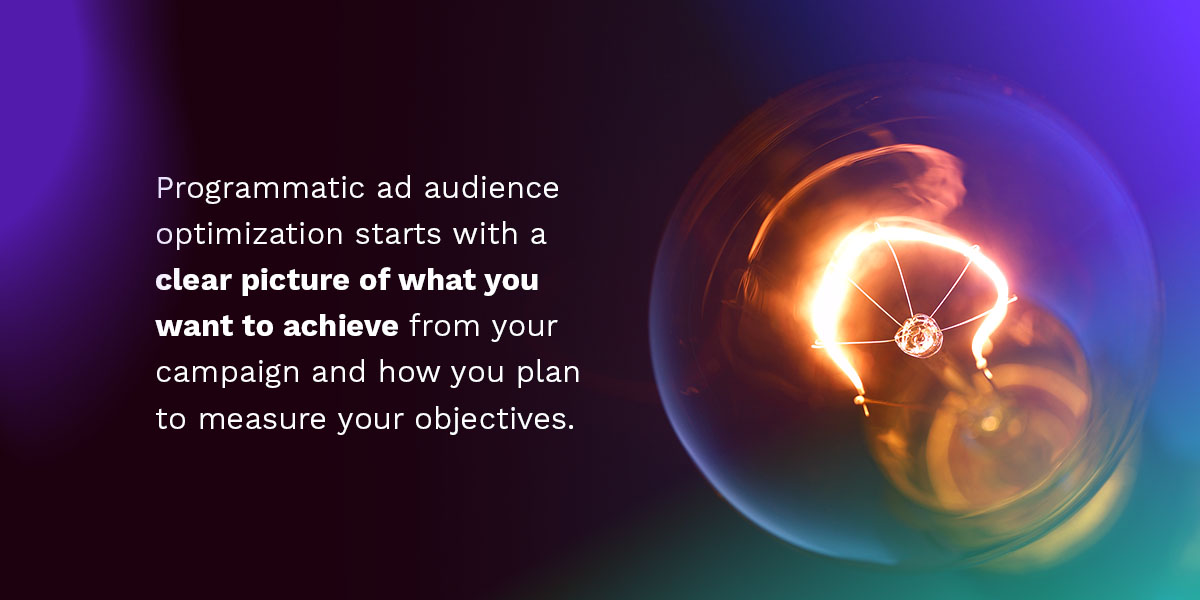Programmatic advertising has enabled companies to leverage AI to buy and sell digital ad space to target specific audiences. Programmatic ad audience optimization takes campaigns further. It delivers more targeted messages to the right audiences in real time. The results have revolutionized the world of digital advertising and led to more agencies focused on targeting strategies in programmatic campaigns.
The cost of advertising is increasing worldwide, and audience profiling in programmatic advertising reduces wastage and increases your return on investment (ROI) by catching people in the moment and appealing to their hobbies, likes, dislikes and lifestyle choices.
Audience targeting in programmatic advertising
Programmatic advertising provides advertisers with an unprecedented advantage — only paying for ads that reach the right audiences. Programmatic advertising can gather a significant amount of audience data, helping advertisers find the right audiences and continue to target them with personalized messages.
Traditional display advertising relies on hoping the right people come across your ad. Predicting results is challenging, and you can accumulate significant costs in extended experimentation. Now, programmatic advertising can target specific groups depending on your chosen characteristics. Each ad is based on an individual opportunity, and you can target the right audiences at the right time.
Audience targeting — also known as audience profiling or segmentation — is taking your entire audience of prospective buyers and splitting it into groups based on different criteria. It helps you to customize messages to specific pain points and create the most inviting consumer experience for each group. The result is impactful advertising from the top to the bottom of the sales funnel.
Programmatic targeting is a simple method of using an audience’s online behavior to target their needs. This method has several targeting options, ranging from lifestyle habits to intent. The process involves gathering user data and answering each group’s questions and concerns. Creating meaningful campaigns is the next step once you have the needed data.
Types of targeting data
How you appeal to consumers depends on the type of data you need to create their profiles. There are many types of targeting data, the most common of which include:
- Demographic data: Also known as audience data, this data segments audiences based on demographic traits such as gender, age, income and interests. For example, women of a similar age who earn an above-average income may respond well to a particular message.
- Contextual data: Contextual data determine the types of content people view on websites and allows relevant ads to appear with related content, often on publisher sites. An example would be reading a pet food comparison and seeing an ad for pet accessories.
- Psychographic data: This type of data is related to people’s interests, hobbies, values, personality traits and lifestyle choices. Like behavioral data, it’s another way of understanding why people make purchase decisions.
- Intent data: This type of data refers to people’s habits, shopping behaviors and interests. It leverages people’s unique lifestyles and considers what people do when visiting a website, like adding items to a cart and leaving the site without purchasing. Targeting behavioral data lets you appeal to an audience’s “why.” If they regularly show behaviors that indicate they prioritize a healthy lifestyle, an ad for fitness apparel would be an example of behavioral targeting.
- Geo-contextual data: Geo-contextual data is location-based. It enables you to target people in a specific area in real-time, like an ad for a free dessert special aimed at people within a certain radius of a restaurant. Millions of people in the United States use smartphone apps that allow location tracking, making this type of targeting data possible.
- Retargeting: Retargeting leverages data from users who’ve previously interacted with your brand. With this information, you can encourage re-engagement and future purchases.
6 Best practices for audience segmentation in programmatic
One of the principal benefits of programmatic advertising is the ability to create and test audience segments. Selecting the right audience segments for specific campaigns can elevate campaign performance and generate actionable insights to power future strategies.
The following best practices can help ensure you get the best possible ROI from your programmatic targeting efforts:
1. Define goals and key performance indicators

Programmatic ad audience optimization starts with a clear picture of what you want to achieve from your campaign and how you plan to measure your objectives. You may have different purposes for each audience segment, requiring their own set of key performance indicators (KPIs). Clear goals and KPIs ensure your segmentation strategy aligns with your advertising strategy.
2. Gather data from multiple sources
The more data points you have, the more effectively you can segment and target your audience. Gather first-, second- and third-party data to enrich your audience segments with more information. Cross-reference and validate your sources where possible. Get data from multiple sources, learn as much as possible and recycle it to inform a different audience segment. Making the most of your data is essential to elevate your segmentation strategy.
3. Identify your most valuable audience segments
At first glance, your most valuable segment is the one that opens, clicks and converts. However, segmentation gives you deeper insights. One of the most critical metrics to consider is the lifetime value — those customers predicted to be worth the most to you throughout their time with you.
Look beyond present information when you create your segments, or you could miss out on leveraging some of your most valuable audiences. Experiment and learn what works for different audiences within your group of the most valuable audience segments.
4. Build custom segments
Plenty of predefined audience segments are available from third-party data providers, but limiting yourself to these could mean you bypass valuable data aligned with your specific goals. You can use first-party data to create custom segments, such as information-seekers subscribed to your newsletter, loyal customers, and those who only interact with your brand a few times a year to buy gifts.
Based on shared attributes, you can create lookalike segments that resemble your existing customers or prospects. Creating custom segments allows you to tailor your programmatic media to your niche audience, increasing your chances of reaching the right people at the right time.
5. Diversify media
Running a programmatic campaign across devices is an effective method for reaching multiple audience segments. By 2027, 72% of total ad spending will be generated through mobile. You can segment your audience further by targeting their devices and creating dynamic ads across various screen sizes. Diversifying your media plan can reduce wastage and help you connect with your highest-value audiences on every platform they use to engage with content.
6. Have a strategy that leverages all audiences
Third-party cookies and mobile advertising IDs (MAIDs) have played a critical role in digital advertising, but many browsers have already phased them out. Without cookies to help you identify and target consumers, you must tweak your strategy to leverage ID-based audiences and create solutions for ID-less audiences to maintain accuracy and scale. This strategy includes focusing on first-party data and integrating universal IDs into your advertising campaign.
Contextual data is likely to take a leading role in the wake of the removal of cookies. This method targets audiences based on keywords and themes, so cookies aren’t required. Contextual segmentation in itself gives you essential information on the audience’s preferences, interests, hobbies and purchasing patterns.
Maximize your advertising strategy with Emodo
Understanding the power of audience segmentation and using best practices to guide your strategy can maximize ROI and build a personalized ad campaign that targets the right audiences at the perfect moment. At Emodo, we believe in combining the power of data with creative you can feel. We create dynamic and immersive ad experiences to drive impact for your campaigns.
Feel the Emodo difference in every connection you make from the outset. Our three-part approach includes:
- Clean: We start with the most robust location data and cleanse it using trusted Ericsson and mobile carrier data.
- Customize: We take this clean data and use it to customize and tailor unique audience segments. These segments are built for accuracy to ensure measurement success.
- Deliver: Emodo’s AI and trusted verification processes will leave you confident you’re reaching the right audiences — with or without the presence of an ID.
Prepare for the industry shift away from cookies and MAIDS with our audience targeting and contextual solutions. Reimagine native advertising with Emodo Adapt and target the right audiences every time. Contact us today to deepen your reach and create personal connections and creative that performs!
MORE LIKE THIS



